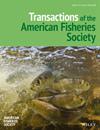Unique diet and Philonema sp. infections in reservoir‐rearing juvenile Chinook Salmon
IF 2
3区 农林科学
Q2 FISHERIES
引用次数: 0
Abstract
Dams and reservoirs can alter juvenile growth and survival of migratory salmonids through several physical and biological mechanisms. Juvenile Chinook Salmon Oncorhynchus tshawytscha that are produced upstream of large hydropower dams may have associated passage mortality, but the reservoirs created by these dams can support rapid growth. Characterizing the biotic drivers of growth and mortality in reservoirs may aid in understanding the cumulative effects of river impoundments on migratory salmonid populations. The purpose of this study was to understand how reservoirs facilitate rapid growth in juvenile Chinook Salmon.We analyzed stomach contents to determine diet composition throughout the summer and fall. We also recorded prevalence of the parasitic nematode Philonema sp. in the coeloms of fish.We found that juvenile Chinook Salmon frequently consumed young‐of‐year centrarchids, which likely contributed to rapid growth. Piscivory was highest from July through October and decreased with surface temperature from November through December. Correspondingly, zooplankton and arthropod consumption increased in November and December. Prevalence of visible Philonema sp. infections in the coelom was high (34.6%), negatively associated with time, and nonlinearly associated with fork length.These findings reveal unique diet patterns and suggest potential parasite‐associated mortality in reservoir‐rearing Chinook Salmon, but more detailed studies across a longer time scale are needed to robustly assess the population‐level effects of this parasite.水库饲养的大鳞大麻哈鱼幼鱼的独特饮食和 Philonema sp.
大坝和水库可通过多种物理和生物机制改变洄游鲑科鱼类幼鱼的生长和存活。在大型水电大坝上游生长的幼年奇努克鲑 Oncorhynchus tshawytscha 可能会有相关的通过死亡率,但这些大坝形成的水库可以支持其快速生长。确定水库中生长和死亡的生物驱动因素可能有助于了解河流蓄水对洄游鲑鱼种群的累积影响。本研究的目的是了解水库如何促进大鳞大麻哈鱼幼鱼的快速生长。我们分析了胃内容物,以确定整个夏季和秋季的食物组成。我们还记录了寄生线虫 Philonema sp.在鱼体中的流行情况。我们发现,大鳞大麻哈鱼幼鱼经常摄食年幼的中心鱼类,这很可能会促进其快速生长。7 月至 10 月间,食鱼量最大,11 月至 12 月间,食鱼量随地表温度的升高而减少。相应地,浮游动物和节肢动物的摄食量在 11 月和 12 月有所增加。这些发现揭示了水库饲养的大鳞大麻哈鱼独特的饮食模式,并表明其死亡率可能与寄生虫有关,但需要在更长的时间尺度内进行更详细的研究,以有力地评估这种寄生虫对种群的影响。
本文章由计算机程序翻译,如有差异,请以英文原文为准。
求助全文
约1分钟内获得全文
求助全文
来源期刊
CiteScore
2.90
自引率
7.10%
发文量
48
审稿时长
8-16 weeks
期刊介绍:
Transactions of the American Fisheries Society is a highly regarded international journal of fisheries science that has been published continuously since 1872. It features results of basic and applied research in genetics, physiology, biology, ecology, population dynamics, economics, health, culture, and other topics germane to marine and freshwater finfish and shellfish and their respective fisheries and environments.

 求助内容:
求助内容: 应助结果提醒方式:
应助结果提醒方式:


